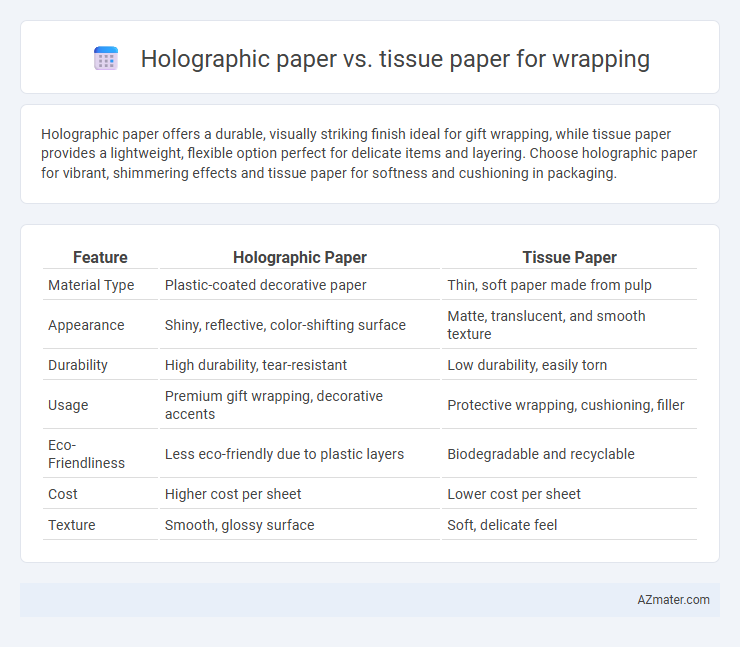Holographic paper offers a durable, visually striking finish ideal for gift wrapping, while tissue paper provides a lightweight, flexible option perfect for delicate items and layering. Choose holographic paper for vibrant, shimmering effects and tissue paper for softness and cushioning in packaging.
Table of Comparison
| Feature | Holographic Paper | Tissue Paper |
|---|---|---|
| Material Type | Plastic-coated decorative paper | Thin, soft paper made from pulp |
| Appearance | Shiny, reflective, color-shifting surface | Matte, translucent, and smooth texture |
| Durability | High durability, tear-resistant | Low durability, easily torn |
| Usage | Premium gift wrapping, decorative accents | Protective wrapping, cushioning, filler |
| Eco-Friendliness | Less eco-friendly due to plastic layers | Biodegradable and recyclable |
| Cost | Higher cost per sheet | Lower cost per sheet |
| Texture | Smooth, glossy surface | Soft, delicate feel |
Introduction to Wrapping Paper Choices
Holographic paper offers a shiny, reflective surface ideal for festive occasions and luxury packaging, enhancing visual appeal with vibrant light effects. Tissue paper, known for its softness and flexibility, provides a delicate cushioning layer often used to protect fragile items and create an elegant finish. Choosing between holographic and tissue paper depends on the desired aesthetic impact and functional wrapping needs, such as protection versus decorative emphasis.
What is Holographic Paper?
Holographic paper is a specialized wrapping material featuring a reflective, rainbow-like surface created through micro-embossing techniques that refract light into various colors. Unlike tissue paper, which is lightweight, porous, and often used for delicate wrapping or padding, holographic paper provides a visually striking, shimmering effect ideal for gift wrapping and decorative purposes. This durable, glossy paper enhances presentation by adding a vibrant, eye-catching appeal that tissue paper cannot achieve.
What is Tissue Paper?
Tissue paper is a lightweight, thin paper often used for wrapping delicate items, providing a soft protective layer that prevents scratches and damage. It is highly absorbent and biodegradable, making it an eco-friendly option for gift wrapping and packaging. Compared to holographic paper, tissue paper offers a matte, translucent finish ideal for cushioning fragile objects.
Visual Appeal: Holographic vs Tissue Paper
Holographic paper features a vibrant, reflective surface that creates dynamic light effects, making it ideal for eye-catching gift wrapping and festive presentations. Tissue paper offers a soft, matte finish that provides a delicate and elegant look, often used for layering and cushioning inside gift bags or boxes. The choice between holographic and tissue paper depends on whether a bold, shimmering appearance or a subtle, refined aesthetic is desired for the wrapping.
Durability and Protection Comparison
Holographic paper offers superior durability compared to tissue paper, featuring a more robust surface that resists tearing and moisture, making it ideal for protecting gifts during transport. Tissue paper is thinner and more delicate, providing minimal protection but excelling in cushioning and creating aesthetic layers within wrapping. For applications requiring enhanced protection and long-lasting appearance, holographic paper outperforms tissue paper by maintaining structural integrity and offering moisture resistance.
Eco-Friendliness and Sustainability
Holographic paper is often coated with plastic or metallic films, making it less biodegradable and challenging to recycle, whereas tissue paper is typically made from biodegradable, recycled materials that break down more easily in the environment. Tissue paper's low-impact production process and compostability contribute significantly to sustainable wrapping practices, reducing landfill waste and environmental footprint. Choosing tissue paper over holographic paper supports eco-friendly packaging by promoting renewable resources and minimizing non-recyclable waste.
Cost and Availability
Holographic paper typically costs more than tissue paper due to its specialized manufacturing process and eye-catching reflective properties. Tissue paper is widely available and budget-friendly, making it a popular choice for bulk wrapping and general gift presentation. Retailers and craft stores stock tissue paper extensively, while holographic paper may require purchasing from specialty suppliers, affecting procurement ease and price.
Best Uses for Holographic Paper
Holographic paper offers a striking, reflective surface ideal for gift wrapping special occasions such as birthdays, holidays, and events where visual impact is key. Its durability and vibrant, multi-dimensional appearance make it perfect for decorative projects requiring a premium look, including party favors, luxury packaging, and festive decorations. Unlike tissue paper, holographic paper resists tearing easily and maintains its structural integrity, making it best suited for wrapping items that demand a combination of strength and eye-catching aesthetics.
Best Uses for Tissue Paper
Tissue paper is ideal for delicate gift wrapping, providing lightweight protection and an elegant finish suited for fragile items like glassware and jewelry. Unlike holographic paper, which is heavier and primarily decorative, tissue paper offers cushioning and prevents scratches during handling and transport. Its breathability and flexibility make it perfect for layering inside gift bags or wrapping multiple objects gently.
Final Verdict: Which Wrapping Paper Should You Choose?
Holographic paper offers a vibrant, eye-catching finish ideal for festive or luxury gift wrapping, while tissue paper provides a lightweight, eco-friendly option perfect for delicate or layered presentations. Choose holographic paper when aiming for a bold, reflective effect that enhances the gift's visual appeal; opt for tissue paper to achieve softness, breathability, and ease of recycling. The final verdict depends on your priority: striking aesthetics call for holographic paper, whereas sustainability and subtle elegance favor tissue paper.

Infographic: Holographic paper vs Tissue paper for Wrapping
 azmater.com
azmater.com